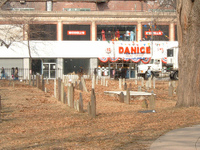
Here is OTBKB’s monthly feature from the Center for the Urban Environment. This post is by Margaret Stevens, an Educator at the Center.
Although the cemetery of Brooklyn ’s Flatbush Dutch Reformed Church is a beautiful, historic place, it receives few visitors. The last time I walked through the cemetery, I spoke to one of those rare souls who find themselves drawn to its bucolic green. The woman had lived in the neighborhood for years, but had never been inside the cemetery before. She was struck by how beautiful it was.
"Why," she asked me, "are they letting the stones fall apart?" It was a good question, but I didn’t know the answer.
The first time I happened upon the cemetery myself, I was amazed to see Dutch inscribed gravestones from the 18th century, and was similarly puzzled by its stark disrepair. It seemed strange that such an historic and lovely place was being allowed to fall into ruin. When I looked the cemetery up online later, I found that there was almost no information about it. Googling yields only articles about the church to which it is connected. According to Brooklyn by Name, however, the Flatbush Dutch Reformed Church is Brooklyn ‘s earliest church. The original church building, no longer in existence, was built in 1654 and Church Avenue , which used to be called Church Lane , is named after this building.
The cemetery lies in the heart of Flatbush, bounded by Church and Flatbush Avenues. In addition to being quiet, peaceful and green, it offers the New York experience of being in multiple worlds at once. You can sit and admire a gravestone decorated with crudely carved cherubs and skulls, and try to puzzle out Dutch words like “begraaven” and “huys vrouw”—and find yourself transported back in time. But a quick look across the street jolts you out of your reverie. Like much of the city, the old and new lie in close proximity to one another and your eye can just as easily lift to the bustle in front of Fabco Shoes or Wallgreens as to the rustling leaves and historic gravestones of its neighboring lot.
With juxtapositions like these, it is well worth a visit. Take the Q or the B to the Church Avenue Station, and walk East to 890 Church Avenue. – Margaret Stevens, Educator, Center for Urban Environment.

Rev. Meeter, Rebeccah Welch here from the Center for the Urban Environment. Thank you for your thoughtful comments. It is always wonderful to get additional information from the community when we do these posts! And we are indebted to OTBKB for the opportunity. I will be in touch directly soon. Rebeccah
I know this congregation very well; it is the older sister to Old First. Let me just say, to fill in the picture, that this congregation does amazing amounts of hands on ministry in its neighborhood; programs in education, feeding the hungry, support for mentally and physically disabled people, spiritual education, free summer programs for kids with working parents, etc. etc. etc. Its financial resources are very limited, and they have made a choice to spend their limited funds on caring for people today instead of historical preservation. I don’t know if I would have made the same choices, but their choices are made with integrity, considering their mission.
Daniel Meeter, pastor of Old First
Maybe I should lead a tour or something. I am there quite frequently, like tonight for example.